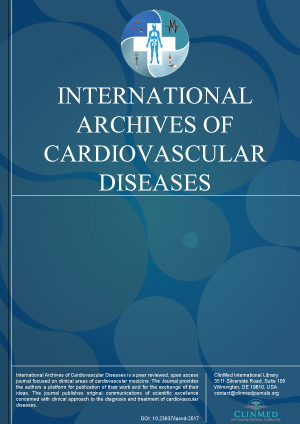Open Access DOI:10.23937/2643-3966/1710025
Coronary Artery Involvement Following Kawasaki Disease: A Case Report of a 5 Month Old African Infant
Tumwebaze Hilda, Ndagiire Emma, Namuyonga Judith, Twalib Aliku, Lwabi Peter and Lubega Sulaiman
Article Type: Case Report | First Published: November 07, 2019
Kawasaki disease (KD) is an acute systemic vasculitis which progresses to cause coronary artery abnormalities as a complication. Echocardiographic and cardiac angiographic data indicate that 20-40% of untreated KD patients develop coronary artery abnormalities. However, majority of the lesions regress over time. Timely treatment with high dose intravenous immunoglobulins (IVIG) and high dose of aspirin has been found reduce the incidence of developing coronary artery aneurysms to 2%-3%. Data on ...
Open Access DOI:10.23937/2643-3966/1710024
Relationship Between Mean Platelet Volume-to-Platelet Count Ratio and the Presence and Severity of Coronary Artery Ectasia
Ramazan Asoglu and Emin Asoglu
Article Type: Research Article | First Published: September 28, 2019
Atherosclerosis plays an essential role in the etiopathogenesis of coronary artery ectasia (CAE). The mean platelet volume/platelet count (MPV/PLT) ratio is a new biomarker, and increased MPV/PLT ratio was a predictor of cardiovascular mortality in patients with the acute coronary syndrome. We aimed to assess the association between the CAE and MPV/PLT ratio. The present study included 50 patients with CAE and 45 healthy subjects prospectively. The CAE was defined as dilation of the coronary art...
Open Access DOI:10.23937/2643-3966/1710023
Saphenous Vein Graft Aneurysm and Coronary Artery Disease: Case Report
Victor Rodrigues Ribeiro Ferreira, Maria Christiane Valeria Braga Braile-Sternieri, Eliana Migliorini Mustafa, Giovanni Braile Sternieri, Sofia Braile Sabino, Cibele Olegário Vianna Queiroz, Bethina Canaroli Sbardellini, Luiza Braile Verdi, Idiberto José Zotarelli Filho and Domingo Marcolino Braile
Article Type: Case Report | First Published: September 28, 2019
Despite a general reduction in the number of myocardial revascularization surgeries in recent decades, more than 150,000 are still performed annually in the United States. Early complications of venous graft use include an occlusion rate of up to 25% in the first year. The aneurysmal dilatation of the great saphenous vein, when used in aorto- coronary venous bridges, is rare and requires important care by the cardiology team. This study aimed to present a case report on saphenous vein aneurysm i...
Open Access DOI:10.23937/2643-3966/1710022
Cardiac Interventions in Symptomatic Patients ≥ 90-Years-Old (Nonagenarians): A Single-Center Retrospective Analysis of Spectrum and Outcome
Philippe N Muller, Christine H Attenhofer Jost, MD, Osmund Bertel, MD, Barbara Naegeli, MD, Edwin Straumann, MD, Pierre Levis, MD, Burkhardt Seifert, Dominik Maurer, MD, Christoph Scharf, MD, Olaf Franzen, MD and Franz Wolfgang Amann, MD
Article Type: Research Article | First Published: August 28, 2019
The database at our center from 2005-2014 was searched for all percutaneous cardiac procedures, including coronary angiography with or without percutaneous coronary intervention (PCI), transcatheter aortic valve replacement (TAVR), percutaneous mitral valve repair by MitraClip (PMVR), balloon valvuloplasty of the aortic valve (ABVP) and radiofrequency ablation (RFA). Age at procedure, clinical data, type and findings at procedure, in-hospital outcome, survival and predictors for survival were an...
Open Access DOI:10.23937/2643-3966/1710021
Case Report: A 13 Years Old Boy with Danon Disease, and Intellectual Disability
Alawni O, Almusaad A and Eyaid W
Article Type: Case Report | First Published: August 26, 2019
A 13-years-old boy. He was born at home at 30 weeks of gestation. He stayed in nursery for 3 months. He sat independently at the age of one year, walked at around 3 years and started to run around 4 years of age. Currently, he can walk, and run well. He wears his clothes, button, and unbutton his shirts. He copies letters, scripts and shapes however; he usually does not follow lines. He spoke at the age of 2 years it was single words like mama and dada....
Open Access DOI:10.23937/2643-3966/1710020
Left Ventricular Hypertrophy in a Patient with AL Amyloidosis: A Rare Overlap of Two Cardiomyopathies
Brock M, Sanchorawala V, Berk JL, Cui H, Gopal DM, O'Hara C, Ruberg FL and Siddiqi OK
Article Type: Case Report | First Published: August 26, 2019
A 62-year-old woman with newly diagnosed systemic AL amyloidosis was evaluated for severely increased left ventricular (LV) wall thickness. Her echocardiographic, cardiac MRI, and genetic findings led to a diagnosis of hypertrophic cardiomyopathy (HCM). Five years after achieving relative a partial hematologic response with chemotherapy, the patient died after developing rapidly progressive heart failure and cardiogenic shock. A full autopsy diagnosed both cardiac amyloidosis and HCM. The overla...

